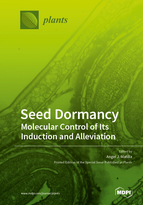Seed Dormancy: Molecular Control of Its Induction and Alleviation
A special issue of Plants (ISSN 2223-7747). This special issue belongs to the section "Plant Physiology and Metabolism".
Deadline for manuscript submissions: closed (30 April 2020) | Viewed by 34549
Special Issue Editor
Interests: molecular and physiological aspects of seeds development
Special Issues, Collections and Topics in MDPI journals
Special Issue Information
Dear Colleagues,
The seed, a key entity in the life cycle of higher plants, allows and ensures its survival by acquiring primary dormancy, which is hormonally induced and then maintained and strictly regulated by the modulation of a suitable hormonal signaling network. The dormancy of some seeds can be relieved through a tightly regulated process called after-ripening (AR) that occurs in dry, mature, and viable seeds stored in dry conditions. As a result of AR, abundant changes of transcripts take place and the window of environmental conditions that allow seed germination widens. The events occurring during this loss of dormancy are of significant functional, ecological, and agricultural interest. Genetic, –omics, and physiological studies about AR have shown the key role of the balance between gibberellins (GAs) and abscisic acid (ABA) metabolism and sensitivity. Recent evidence also supports a possible role of ethylene in AR execution and modulation. However, hormone-independent signals (e.g., reactive oxygen species (ROS) and nitrate) also appear to be involved in the triggering and maintenance of AR. The way in which hormone- and non-hormone-signaling pathways affect each other is still scarcely known. With all these aforementioned factors put together, the implementation of AR involves genes associated with the completion of germination. Nevertheless, the complexity and diversity of mechanisms that trigger and control AR is a great puzzle, with the majority of its pieces still missing.
Prof. Angel J. Matilla
Guest Editor
Manuscript Submission Information
Manuscripts should be submitted online at www.mdpi.com by registering and logging in to this website. Once you are registered, click here to go to the submission form. Manuscripts can be submitted until the deadline. All submissions that pass pre-check are peer-reviewed. Accepted papers will be published continuously in the journal (as soon as accepted) and will be listed together on the special issue website. Research articles, review articles as well as short communications are invited. For planned papers, a title and short abstract (about 100 words) can be sent to the Editorial Office for announcement on this website.
Submitted manuscripts should not have been published previously, nor be under consideration for publication elsewhere (except conference proceedings papers). All manuscripts are thoroughly refereed through a single-blind peer-review process. A guide for authors and other relevant information for submission of manuscripts is available on the Instructions for Authors page. Plants is an international peer-reviewed open access semimonthly journal published by MDPI.
Please visit the Instructions for Authors page before submitting a manuscript. The Article Processing Charge (APC) for publication in this open access journal is 2700 CHF (Swiss Francs). Submitted papers should be well formatted and use good English. Authors may use MDPI's English editing service prior to publication or during author revisions.
Keywords
- AR mutants
- cell wall degradation
- monocot- and dicot-seeds
- phytohormones
- RBOHD genes
- ROS homeostasis mutants
- seed pathogenesis
- specific regulators of AR
- tissue specificity of gene expression







